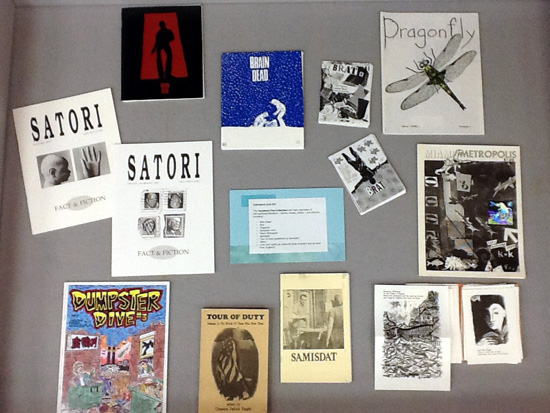
April 2016
The Library's seventh floor exhibit for April focused on zines from the Factsheet Five Collection (SC20329). The term "zines" (pronounced "zeens") encompasses a variety of self-published periodicals and small press publications. They are generally intended for a small audience interested in a particular topic, often topics considered to be alternative, radical, or fringe and therefore not covered by the mainstream press. Or as Mike Gunderloy put it, "It's hard to say what defines a zine, though...generally, they're created by one person, for love rather than money, and focus on a particular subject." (Gunderloy, The World of Zines: A Guide to the Independent Magazine Revolution, p.2)

Factsheet Five was a zine that reviewed other zines and small press publications. It was created by Mike Gunderloy in 1982 as a review zine designed to cross connect the libertarian movement and science fiction fans. (The title comes from a science fiction story by John Brunner). The publication soon grew to encompass other topics, however, eventually reviewing thousands of underground, alternative and privately-produced publications on a wide array of topics, such as comics, art, music, film, literature, politics, religion, and sports. Gunderloy's involvement in Factsheet Five ended with issue #44, published in 1991. Hudson Luce purchased the rights to Factsheet Five, but published only one issue, #45; then R. Seth Friedman took over, publishing the zine for five years in San Francisco, until issue #64 in 1998.
In 1992, Gunderloy donated the business records he had accumulated while publishing the zine – including issues of zines and publications reviewed in Factsheet Five, ephemera, and mail art – to the New York State Library. The collection is an excellent resource for researching not only zines themselves but the communities which used them as a means of communication.
Items on display in the image above include a Factsheet Five T-shirt and issues spanning both the Gunderloy era and the post-Gunderloy era. The issues also show some of the formatting changes the zine underwent, as it grew from a simple one-page sheet to a more professional publication with a glossy, colored cover.
The cover of issue #56 (image at top of page), which asks "Paper or Plastic?" as it shows a muscled, computer-headed bully kicking sand – or silicon – in the face of a scrawny man with a print zine for a head, may illustrate the fate of Factsheet Five itself, as well as many other zines – as the Internet became widely available, it provided a new way for fans of various subcultures to connect, and many of the print publications either moved online or simply disappeared.
As Factsheet Five grew, the scope of material it reviewed expanded as well, eventually encompassing publications (and other items) intended for communities as widely varied as wrestling fans, B-movie fans, pagan religious communities, and political groups on both the left and right. The items on display included:


The Factsheet Five Collection has many examples of self-published literature – stories, essays, poetry – and artwork, including:


Another popular genre within the Factsheet Five Collection is comics, with items ranging from original comic books to guides for self-publishing comics to reviews and price guides. Items on display included:

Science fiction, the original focus of Factsheet Five, was represented in the exhibit by these titles:
The collection also includes many of the cover letters that came with submissions, as well as the envelopes they were sent in - sometimes the container was part of the message, with elaborately embellished envelopes that could be as interesting as their contents.

Exhibit curated by Diane Madrigal and Joelle Adler